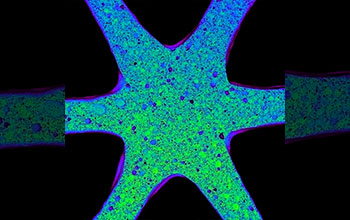Multimedia Gallery
3D printing mimics nature’s cellular architectures
A close-up of one node of a triangular honeycomb. The structure, which consists of air surrounded by ceramic, can be designed with specific porosity. Researchers, inspired by natural cellular structures, have developed a new method to 3D print materials with independently tunable macro- and microscale porosity using a ceramic foam ink.
More about this image
Inspired by natural cellular structures, researchers at the Harvard John A. Paulson School of Engineering and Applied Sciences (SEAS), the Wyss Institute for Biologically Inspired Engineering at Harvard University, and MIT have developed a new method to 3D print materials with independently tunable macro-and microscale porosity using a ceramic foam ink.
Their approach could be used to fabricate lightweight structural materials, thermal insulation or tissue scaffolds.
"By expanding the compositional space of printable materials, we can produce lightweight structures with exceptional stiffness," said Jennifer Lewis, Hansjorg Wyss Professor of Biologically Inspired Engineering at SEAS and senior author of a paper published about the research.
The ceramic foam ink used by the Lewis Lab contains alumina particles, water and air. By controlling the foam’s microstructure, the researchers tuned the ink’s properties and how it deformed on the microscale. Once optimized, the team printed lightweight hexagonal and triangular honeycombs, with tunable geometry, density and stiffness.
The research was supported in part by the National Science Foundation.
Learn more in the NSF News From the Field story Mimicking nature's cellular architectures via 3D printing. (Date image taken: unknown; date originally posted to NSF Multimedia Gallery: Sept. 13, 2018)
Credit: Image courtesy of James Weaver/Wyss Institute
Special Restrictions: This image is made available to non-commercial entities, press and the general public under a Creative Commons Attribution Non-Commercial No Derivatives license. You may not alter this image other than to crop it to size. A credit line must be used when reproducing this image.
Images and other media in the National Science Foundation Multimedia Gallery are available for use in print and electronic material by NSF employees, members of the media, university staff, teachers and the general public. All media in the gallery are intended for personal, educational and nonprofit/non-commercial use only.
Images credited to the National Science Foundation, a federal agency, are in the public domain. The images were created by employees of the United States Government as part of their official duties or prepared by contractors as "works for hire" for NSF. You may freely use NSF-credited images and, at your discretion, credit NSF with a "Courtesy: National Science Foundation" notation.
Additional information about general usage can be found in Conditions.
Also Available:
Download the high-resolution JPG version of the image. (2.7 MB)
Use your mouse to right-click (Mac users may need to Ctrl-click) the link above and choose the option that will save the file or target to your computer.



